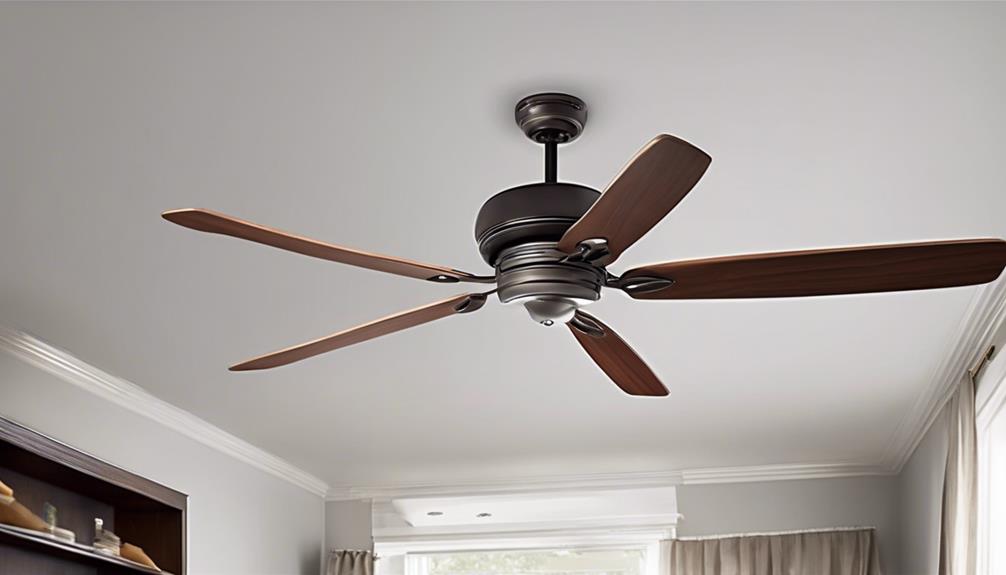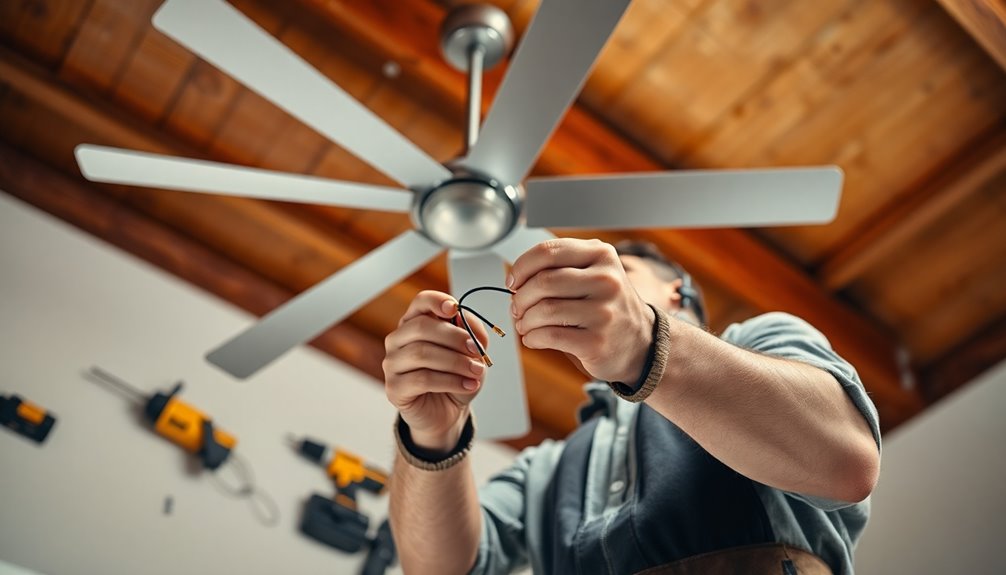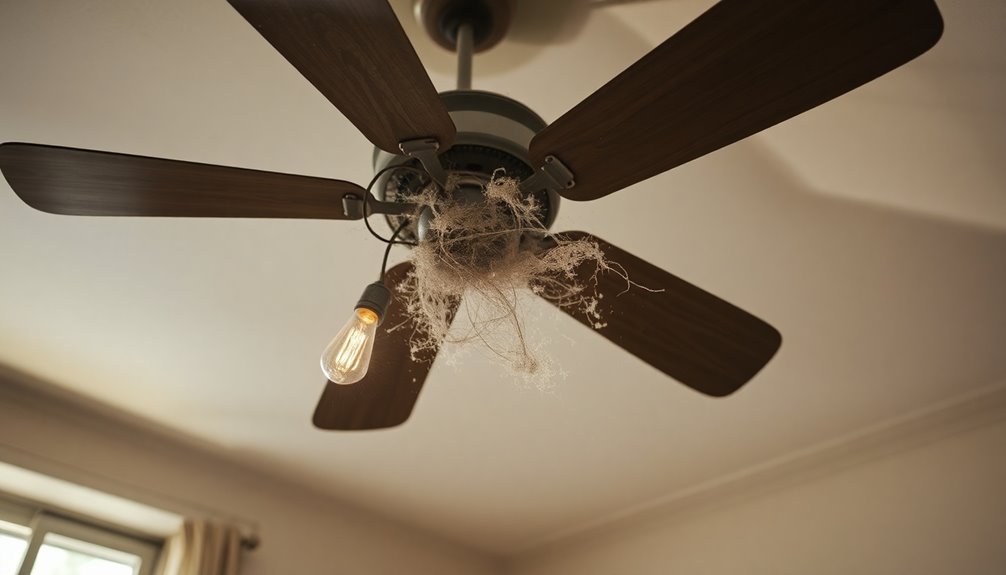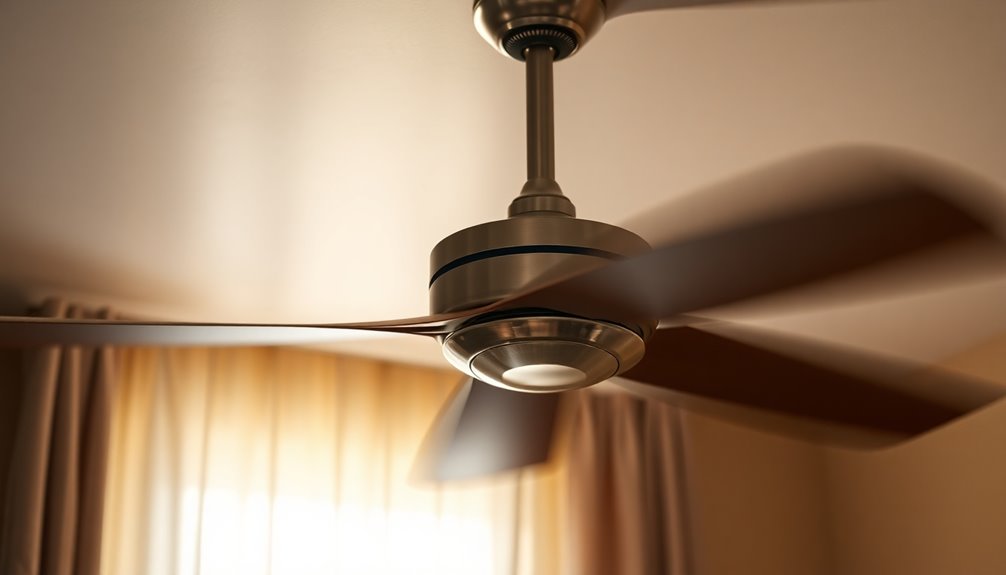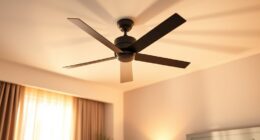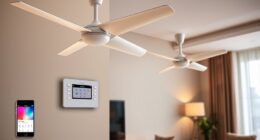A clicking ceiling fan can be dangerous for three main reasons. Firstly, loose connections in the fan can lead to electrical hazards like short circuits and overheating, potentially causing malfunctions and motor strain. Secondly, damaged components indicated by the clicking noise can heighten the risk of fire due to overheating, sparks, and short circuits, emphasizing the importance of prompt attention to prevent serious malfunctions and fire outbreaks.
Lastly, misaligned blades not only reduce efficiency by creating uneven airflow, but they also increase the risk of fan detachment, potentially causing injury or damage. Taking immediate action to address these issues ensures safe operation, minimizes fire risks, and prolongs the fan's lifespan. Understanding these risks can help prevent accidents and ensure the safety of your home and family.
Key Takeaways
- Clicking indicates potential electrical issues like loose connections.
- Damaged components heighten fire risks in a clicking ceiling fan.
- Misaligned blades lead to uneven airflow and wobbling hazards.
- Prompt action prevents fire outbreaks and electrical hazards.
- Addressing issues promptly ensures safe operation and prolongs fan lifespan.
Potential Hazard: Loose Connections
Why are loose connections in a ceiling fan a critical concern for safety and functionality?
Loose connections in a ceiling fan pose significant electrical hazards, such as short circuits and overheating, which can lead to damage and malfunction. When the wiring in a ceiling fan isn't securely connected, it can disrupt the power supply, causing the fan to operate erratically and increasing the risk of a safety hazard. Additionally, loose connections may result in power fluctuations that strain the fan motor, potentially causing premature failure.
Addressing these loose connections promptly is crucial to prevent electrical accidents and ensure the safe operation of the ceiling fan. By securing these connections and ensuring a stable power supply, you can maintain the proper functioning of your ceiling fan and reduce the risk of any safety issues related to its operation. Taking these precautions will help you enjoy a comfortable and worry-free environment while using your ceiling fan.
Fire Risk: Damaged Components

Damaged components in a clicking ceiling fan heighten the risk of fire due to potential electrical issues. When components like loose wiring or faulty connections create the clicking sound, they can lead to overheating, sparks, and even short circuits. Ignoring these warning signs may result in serious electrical malfunctions, posing safety hazards like fire outbreaks.
The continuous clicking noise serves as a crucial indicator of an underlying problem that could escalate into a dangerous situation if left unattended. Addressing these issues promptly is essential to prevent potential fire risks associated with damaged components in a ceiling fan. By taking action to repair or replace the faulty parts causing the clicking sound, you can mitigate the chances of electrical fires and ensure the safety of your home and loved ones.
Safety Concern: Misaligned Blades
Addressing misaligned blades promptly is crucial to ensure the safe operation of a ceiling fan and prevent potential hazards. Misaligned blades can lead to uneven airflow, reducing the fan's efficiency. Additionally, they can cause excessive wobbling, increasing the risk of the fan detaching from the ceiling. This wobbling may also result in the fan hitting the ceiling or other nearby objects, posing a safety hazard.
Moreover, misaligned blades can put stress on the motor and other components, potentially causing damage and malfunctions. It's essential to address misaligned blades promptly to prevent further issues and maintain the safety and functionality of the ceiling fan.
Regularly checking and adjusting the alignment of the blades can help ensure smooth and safe operation, prolonging the lifespan of the fan and minimizing risks associated with misalignment.
Frequently Asked Questions
Is a Clicking Ceiling Fan Dangerous?
Yes, a clicking ceiling fan can be dangerous. It may indicate loose parts that can lead to falling blades or light fixtures, posing a risk of injury. Additionally, loose connections could cause electrical hazards like shocks or short circuits.
To address this, prioritize fan maintenance, check for potential hazards, and seek professional inspection if needed. Safety precautions, electrical safety, and prompt repairs are crucial to prevent accidents and ensure a secure environment.
Is a Noisy Fan Dangerous?
A noisy fan can be dangerous due to potential underlying issues like loose components or electrical hazards. If left unaddressed, these problems may escalate, compromising the fan's safety.
Regular fan maintenance is crucial to prevent safety concerns caused by noise levels, electrical issues, wobbling blades, or motor problems. Seeking professional help for installation errors, blade balancing, or remote control malfunction can ensure a safe and functional fan.
Are you prioritizing fan maintenance for safety?
Why Is My Ceiling Fan Clicking?
When my ceiling fan starts clicking, it's usually a sign that something's loose or damaged. To address this, I check the fan's components, like blades and motor mountings, for any issues.
If I can't DIY fix it, seeking professional help is key to prevent safety hazards and keep the fan running smoothly.
Regular maintenance and timely repairs can reduce noise, ensure electrical safety, and extend the fan's lifespan.
Can a Noisy Ceiling Fan Fall Down?
A noisy ceiling fan can pose a safety risk if left unchecked. Loose components or faulty connections may compromise its stability, potentially causing it to fall. To prevent this, regular maintenance, prompt repairs, and ensuring secure installation are key safety precautions.
DIY fixes can help reduce noise, but professional inspections and repairs may be necessary. Considering the fan's weight and home insurance coverage is also important for maintaining a safe environment.
Is a Clicking Ceiling Fan a Sign of Potential Danger?
If your ceiling fan light flickers or if you hear a clicking sound, it could be a sign of potential danger. A clicking ceiling fan could indicate loose parts or electrical issues. It’s important to address these issues promptly to prevent any potential hazards.
Conclusion
In conclusion, a clicking ceiling fan can pose serious risks such as loose connections, fire hazards, and misaligned blades. It's important to address these issues promptly to ensure the safety of your home and family.
Regular maintenance and inspections can help prevent potential accidents and ensure your ceiling fan operates smoothly and safely. Remember, safety always comes first when it comes to electrical appliances.
